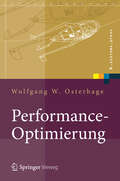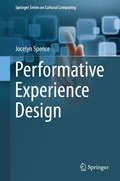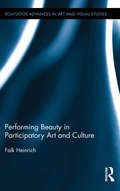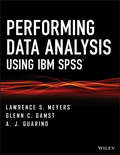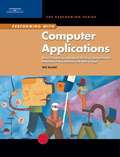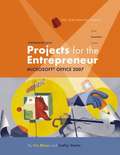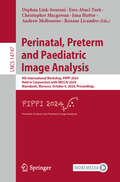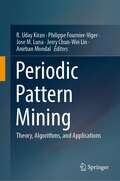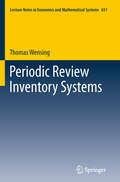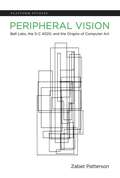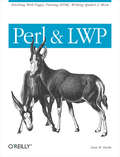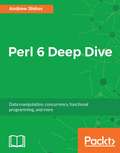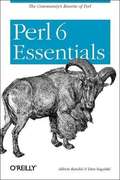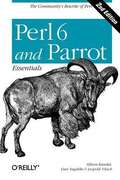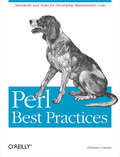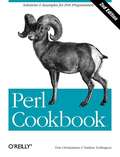- Table View
- List View
Performance-Optimierung
by Wolfgang W. OsterhageComputer-Hardware ist heute zwar erschwinglich, dennoch spielt Performance nach wie vor eine wichtige Rolle - auch wegen der Beanspruchung großer Ressourcen bei komplexen Anwendungen. In dem Band werden drei Ebenen unterschieden (Systeme, Anwendungen und Geschäftsprozesse), auf denen sich Optimierungen erzielen und Kostenpotenziale erschließen lassen. Entsprechende Theorien, Messmethoden sowie Lösungsvorschläge zur Umsetzung von Optimierungsmaßnahmen auf der jeweiligen Ebene werden erläutert. Mit Checklisten für Messungen und Optimierungsmaßnahmen.
Performative Experience Design
by Jocelyn SpenceThisbook presents a novel framework for understanding and designing performativeexperiences with digital technologies. It introduces readers to performancetheory and practice in the context of HCI and gives a practical and holisticapproach for understanding complex interactions with digital technologies atthe far end of third-wave HCI. Theauthor presents a step-by-step explanation of the Performative ExperienceDesign methodology, along with a detailed case study of the design process asit was applied to co-located digital photo sharing. Finally, the text offersguidelines for design and a vision of how PED can contribute to an ethical,critical, exploratory, and humane understanding of the ways that we engagemeaningfully with digital technology. Researchers, students and practitioners working in thisimportant and evolving field will find this state-of-the-art book a valuableaddition to their reading.
Performing Beauty in Participatory Art and Culture (Routledge Advances in Art and Visual Studies)
by Falk HeinrichThis book investigates the notion of beauty in participatory art, an interdisciplinary form that necessitates the audience’s agential participation and that is often seen in interactive art and technology-driven media installations. After considering established theories of beauty, for example, Plato, Alison, Hume, Kant, Gadamer and Santayana through to McMahon and Sartwell, Heinrich argues that the experience of beauty in participatory art demands a revised notion of beauty; a conception that accounts for the performative and ludic turn within various art forms and which is, in a broader sense, a notion of beauty suited to a participatory and technology-saturated culture. Through case studies of participatory art, he provides an art-theoretical approach to the concept of performative beauty; an approach that is then applied to the wider context of media and design artefacts.
Performing Data Analysis Using IBM SPSS
by Lawrence S. Meyers A. J. Guarino Glenn C. GamstFeatures easy-to-follow insight and clear guidelines to perform data analysis using IBM SPSS®Performing Data Analysis Using IBM SPSS® uniquely addresses the presented statistical procedures with an example problem, detailed analysis, and the related data sets. Data entry procedures, variable naming, and step-by-step instructions for all analyses are provided in addition to IBM SPSS point-and-click methods, including details on how to view and manipulate output.Designed as a user's guide for students and other interested readers to perform statistical data analysis with IBM SPSS, this book addresses the needs, level of sophistication, and interest in introductory statistical methodology on the part of readers in social and behavioral science, business, health-related, and education programs. Each chapter of Performing Data Analysis Using IBM SPSS covers a particular statistical procedure and offers the following: an example problem or analysis goal, together with a data set; IBM SPSS analysis with step-by-step analysis setup and accompanying screen shots; and IBM SPSS output with screen shots and narrative on how to read or interpret the results of the analysis.The book provides in-depth chapter coverage of:IBM SPSS statistical outputDescriptive statistics proceduresScore distribution assumption evaluationsBivariate correlationRegressing (predicting) quantitative and categorical variablesSurvival analysist TestANOVA and ANCOVAMultivariate group differencesMultidimensional scalingCluster analysisNonparametric procedures for frequency dataPerforming Data Analysis Using IBM SPSS is an excellent text for upper-undergraduate and graduate-level students in courses on social, behavioral, and health sciences as well as secondary education, research design, and statistics. Also an excellent reference, the book is ideal for professionals and researchers in the social, behavioral, and health sciences; applied statisticians; and practitioners working in industry.
Performing Image (The\mit Press Ser.)
by Isobel HarbisonAn examination of how artists have combined performance and moving image for decades, anticipating our changing relation to images in the internet era.In Performing Image, Isobel Harbison examines how artists have combined performance and moving image in their work since the 1960s, and how this work anticipates our changing relations to images since the advent of smart phones and the spread of online prosumerism. Over this period, artists have used a variety of DIY modes of self-imaging and circulation—from home video to social media—suggesting how and why Western subjects might seek alternative platforms for self-expression and self-representation. In the course of her argument, Harbison offers close analyses of works by such artists as Robert Rauschenberg, Yvonne Rainer, Mark Leckey, Wu Tsang, and Martine Syms.Harbison argues that while we produce images, images also produce us—those that we take and share, those that we see and assimilate through mass media and social media, those that we encounter in museums and galleries. Although all the artists she examines express their relation to images uniquely, they also offer a vantage point on today's productive-consumptive image circuits in which billions of us are caught. This unregulated, all-encompassing image performativity, Harbison writes, puts us to work, for free, in the service of global corporate expansion. Harbison offers a three-part interpretive framework for understanding this new proximity to images as it is negotiated by these artworks, a detailed outline of a set of connected practices—and a declaration of the value of art in an economy of attention and a crisis of representation.
Performing with Computer Applications (Second Edition)
by Iris BlancThe book offers learning activities and projects that are skills-rich to help the students develop the competencies and skills needed for today's workplace and also elaborates on how software tools are used with each other.
Performing with Microsoft® Office 2007
by Iris Blanc Cathy VentoThe Performing Series takes students to a higher level of learning through applied and project-based activities that go beyond the mechanics of the software. Various business documents are shown first, then students are shown the Office 2007 skills they need to create them. This approach shows students the relevance of what they are learning as they apply technology to task.
Performing with Projects for the Entrepreneur: Microsoft® Office 2007
by Iris Blanc Cathy VentoThis workbook provides students the opportunity to practice the skills that they have learned. These projects require students to create documents, forms, presentations, worksheets, databases, Web sites and Outlook management tools for a new business.
Peridynamics and Its Applications Using Ansys
by Yanan Zhang Erdogan Madenci Sundaram Vinod AnicodeThis book introduces a unified implementation of bond- and state-based peridynamic theory (PD) within a commercial finite element framework, Ansys, utilizing its native elements. It details the implementation of the PD theory and its integration with traditional finite elements. The primary objective is to equip students, researchers, and practicing engineers with both theoretical and practical knowledge of the PD theory, along with the skills necessary for analyzing engineering problems using Ansys. The book demonstrates that, unlike the conventional finite element method (FEM), the PD theory is highly suitable for progressive failure analysis, the multi-scale analysis of materials involving fracture and failure, and multi-physics analysis, including electromigration, corrosion, and electrodeposition. Additionally, it provides a step-by-step illustration of the specific procedures in the pre-processing, solution, and post-processing phases of the analysis through the Graphical User Interface (GUI) for various applications. The book is designed to be introductory and self-contained, minimizing the need for additional reference material.
Perinatal, Preterm and Paediatric Image Analysis: 7th International Workshop, PIPPI 2022, Held in Conjunction with MICCAI 2022, Singapore, September 18, 2022, Proceedings (Lecture Notes in Computer Science #13575)
by Christopher Macgowan Andrew Melbourne Roxane Licandro Jana Hutter Esra Abaci TurkThis book constitutes the refereed proceedings of the First International Workshop on Perinatal, Preterm and Paediatric Image Analysis, PIPPI 2022, held in conjunction with the 25th International Conference on Medical Imaging and Computer-Assisted Intervention, MICCAI 2022, in Singapore, Singapore, in September 2021. The 10 full papers and 1 short papers presented at PIPPI 2022 were carefully reviewed and selected from 12 submissions. PIPPI 2022 workshop complements the main MICCAI conference by providing a focused discussion of perinatal and paediatric image analysis, including the application of sophisticated analysis tools to fetal, neonatal and paediatric imaging data.
Perinatal, Preterm and Paediatric Image Analysis: 8th International Workshop, PIPPI 2023, Held in Conjunction with MICCAI 2023, Vancouver, BC, Canada, October 12, 2023, Proceedings (Lecture Notes in Computer Science #14246)
by Christopher Macgowan Andrew Melbourne Roxane Licandro Jana Hutter Esra Abaci Turk Daphna Link-SouraniThis book constitutes the refereed proceedings of the 8th International Workshop on Perinatal, Preterm and Paediatric Image Analysis, PIPPI 2023, held in conjunction with the 26th International Conference on Medical Imaging and Computer-Assisted Intervention, MICCAI 2023, in Vancouver, Canada, in October 2023.The 10 full papers presented at PIPPI 2023 were carefully reviewed and selected from 14 submissions. PIPPI 2023 workshop complements the main MICCAI conference by providing a focused discussion on the challenges of image analysis techniques as applied to the fetal and infant settings.
Perinatal, Preterm and Paediatric Image Analysis: 9th International Workshop, PIPPI 2024, Held in Conjunction with MICCAI 2024, Marrakesh, Morocco, October 6, 2024, Proceedings (Lecture Notes in Computer Science #14747)
by Christopher Macgowan Andrew Melbourne Roxane Licandro Jana Hutter Esra Abaci Turk Daphna Link-SouraniThis book constitutes the refereed proceedings of the 9th International Workshop on Perinatal, Preterm and Paediatric Image Analysis, PIPPI 2024, held in conjunction with the 27th International Conference on Medical Imaging and Computer-Assisted Intervention, MICCAI 2024, in Marrakesh, Morocco, on October 6, 2024. The 14 full papers presented in this book were carefully reviewed and selected from 17 submissions. The methods presented in these proceedings cover the full scope of medical image analysis including segmentation, registration, classification, reconstruction, population analysis and advanced structural, and functional and longitudinal modeling, all with an application to younger cohorts.
Periodic Pattern Mining: Theory, Algorithms, and Applications
by Jerry Chun-Wei Lin Anirban Mondal Philippe Fournier-Viger R. Uday Kiran Jose M. LunaThis book provides an introduction to the field of periodic pattern mining, reviews state-of-the-art techniques, discusses recent advances, and reviews open-source software. Periodic pattern mining is a popular and emerging research area in the field of data mining. It involves discovering all regularly occurring patterns in temporal databases. One of the major applications of periodic pattern mining is the analysis of customer transaction databases to discover sets of items that have been regularly purchased by customers. Discovering such patterns has several implications for understanding the behavior of customers. Since the first work on periodic pattern mining, numerous studies have been published and great advances have been made in this field. The book consists of three main parts: introduction, algorithms, and applications. The first chapter is an introduction to pattern mining and periodic pattern mining. The concepts of periodicity, periodic support, search space exploration techniques, and pruning strategies are discussed. The main types of algorithms are also presented such as periodic-frequent pattern growth, partial periodic pattern-growth, and periodic high-utility itemset mining algorithm. Challenges and research opportunities are reviewed.The chapters that follow present state-of-the-art techniques for discovering periodic patterns in (1) transactional databases, (2) temporal databases, (3) quantitative temporal databases, and (4) big data. Then, the theory on concise representations of periodic patterns is presented, as well as hiding sensitive information using privacy-preserving data mining techniques.The book concludes with several applications of periodic pattern mining, including applications in air pollution data analytics, accident data analytics, and traffic congestion analytics.
Periodic Review Inventory Systems
by Thomas WensingThe focus of the work is twofold. First, it provides an introduction into fundamental structural and behavioral aspects of periodic review inventory systems. Second, it includes a comprehensive study on analytical and optimization aspects of a specific class of those systems. For the latter purpose, general solution methods for problems of inventory management in discrete time are described and developed along with highly specialized methods to solve very specific problems related to the model variants examined. The work is thus addressed to students and practitioners who seek a deeper understanding of managing inventories in discrete time as well as to software developers who require implementation aids on specific problems of inventory management.
Peripheral Interaction
by Saskia Bakker Doris Hausen Ted SelkerComputing devices havebecome ever more present in our everyday environments, however embedding thesetechnologies into our routines has remained a challenge. This book exploresthe novel theory of peripheral interaction to rectify this. This theory examines how interactivesystems canbe developed in such a way to allow people to seamlessly interact withtheir computer devices, but only focus on them at relevant times, building onthe way in which people effortlessly divide their attention over severaleveryday activities in day to day life. Capturing the currentstate of the art within the field, this book explores the history and foundationaltheories of peripheral interaction, discussesnovel interactive styles suitable for peripheral interaction, addressesdifferent application domains which can benefit from peripheral interaction andpresents visions of how thesedevelopments can have a positive impact on our future lives. As such, thisbook's aim is to contribute to research and practice in fields such ashuman-computer interaction, ubiquitous computing and Internet of Things, a viewon how interactive technology could be redesigned to form a meaningful, yetunobtrusive part of people's everyday lives. Peripheral Interaction will be highly beneficial to researchers anddesigners alike in areas such as HCI, Ergonomics and Interaction Design.
Peripheral Vision
by Zabet PattersonIn 1959, the electronics manufacturer Stromberg-Carlson produced the S-C 4020, a device that allowed mainframe computers to present and preserve images. In the mainframe era, the output of text and image was quite literally peripheral; the S-C 4020 -- a strange and elaborate apparatus, with a cathode ray screen, a tape deck, a buffer unit, a film camera, and a photo-paper camera -- produced most of the computer graphics of the late 1950s and early 1960s. At Bell Laboratories in Murray Hill, New Jersey, the S-C 4020 became a crucial part of ongoing encounters among art, science, and technology. In this book, Zabet Patterson examines the extraordinary uses to which the Bell Labs SC-2040 was put between 1961 and 1972, exploring a series of early computer art projects shaped by the special computational affordances of the S-C 4020. The S-C 4020 produced tabular data, graph plotting and design drawings, grid projections, and drawings of axes and vectors; it made previously impossible visualizations possible. Among the works Patterson describes are E. E. Zajac's short film of an orbiting satellite, which drew on the machine's graphic capacities as well as the mainframe's calculations; a groundbreaking exhibit of "computer generated pictures" by Béla Julesz and Michael Noll, two scientists interested in visualization; animations by Kenneth Knowlton and the Bell Labs artist-in-residence Stan VanDerBeek; and Lillian Schwartz's "cybernetic" film Pixillation.Arguing for the centrality of a peripheral, Patterson makes a case for considering computational systems not simply as machines but in their cultural and historical context.
Peripheral Vision: Bell Labs, the S-C 4020, and the Origins of Computer Art (Platform Studies)
by Zabet PattersonHow the S-C 4020—a mainframe peripheral intended to produce scientific visualizations—shaped a series of early computer art projects that emerged from Bell Labs.In 1959, the electronics manufacturer Stromberg-Carlson produced the S-C 4020, a device that allowed mainframe computers to present and preserve images. In the mainframe era, the output of text and image was quite literally peripheral; the S-C 4020—a strange and elaborate apparatus, with a cathode ray screen, a tape deck, a buffer unit, a film camera, and a photo-paper camera—produced most of the computer graphics of the late 1950s and early 1960s. At Bell Laboratories in Murray Hill, New Jersey, the S-C 4020 became a crucial part of ongoing encounters among art, science, and technology. In this book, Zabet Patterson examines the extraordinary uses to which the Bell Labs SC-2040 was put between 1961 and 1972, exploring a series of early computer art projects shaped by the special computational affordances of the S-C 4020. The S-C 4020 produced tabular data, graph plotting and design drawings, grid projections, and drawings of axes and vectors; it made previously impossible visualizations possible. Among the works Patterson describes are E. E. Zajac's short film of an orbiting satellite, which drew on the machine's graphic capacities as well as the mainframe's calculations; a groundbreaking exhibit of “computer generated pictures” by Béla Julesz and Michael Noll, two scientists interested in visualization; animations by Kenneth Knowlton and the Bell Labs artist-in-residence Stan VanDerBeek; and Lillian Schwartz's “cybernetic” film Pixillation.Arguing for the centrality of a peripheral, Patterson makes a case for considering computational systems not simply as machines but in their cultural and historical context.
Perl & LWP: Fetching Web Pages, Parsing HTML, Writing Spiders & More
by Sean M. BurkePerl soared to popularity as a language for creating and managing web content, but with LWP (Library for WWW in Perl), Perl is equally adept at consuming information on the Web. LWP is a suite of modules for fetching and processing web pages.The Web is a vast data source that contains everything from stock prices to movie credits, and with LWP all that data is just a few lines of code away. Anything you do on the Web, whether it's buying or selling, reading or writing, uploading or downloading, news to e-commerce, can be controlled with Perl and LWP. You can automate Web-based purchase orders as easily as you can set up a program to download MP3 files from a web site.Perl & LWP covers:Understanding LWP and its designFetching and analyzing URLsExtracting information from HTML using regular expressions and tokensWorking with the structure of HTML documents using treesSetting and inspecting HTTP headers and response codesManaging cookiesAccessing information that requires authenticationExtracting linksCooperating with proxy cachesWriting web spiders (also known as robots) in a safe fashionPerl & LWP includes many step-by-step examples that show how to apply the various techniques. Programs to extract information from the web sites of BBC News, Altavista, ABEBooks.com, and the Weather Underground, to name just a few, are explained in detail, so that you understand how and why they work.Perl programmers who want to automate and mine the web can pick up this book and be immediately productive. Written by a contributor to LWP, and with a foreword by one of LWP's creators, Perl & LWP is the authoritative guide to this powerful and popular toolkit.
Perl 5 Quick Reference
by Michael FoghluA really handy quick reference manual for the perl web scripting language.
Perl 6 Deep Dive
by Andrew ShitovLearn Perl 6 effortlessly to solve everyday problems About This Book • Filled with practical examples, this comprehensive guide explores all aspects of Perl 6. • Leverage the power of Perl 6 concurrency to develop responsive and high-performant software. • Delves into various programming paradigms (such as Object Oriented, functional, and reactive) that can be adopted by Perl 6 developers to write effective code. Who This Book Is For This book is for developers who would like to learn the Perl programming language. A basic knowledge of programming is assumed. What You Will Learn • Learn the background from which Perl 6 appeared and how it developed. • How to use Rakudo to run your programs. • Various Perl 6 built-in types and details about their behavior • Understand how scalar variables, hash variables, and arrays work • Create meta operators and hyper operators • How classes work and how to build software based on the Object Oriented Paradigm • How Perl 6 provides support for concurrency, functional programming, and reactive programming. In Detail Perl is a family of high-level, general-purpose, interpreted, dynamic programming languages consisting of Perl 5 and Perl 6. Perl 6 helps developers write concise and declarative code that is easy to maintain. This book is an end-to-end guide that will help non-Perl developers get to grips with the language and use it to solve real-world problems. Beginning with a brief introduction to Perl 6, the first module in the book will teach you how to write and execute basic programs. The second module delves into language constructs, where you will learn about the built-in data types, variables, operators, modules, subroutines, and so on available in Perl 6. Here the book also delves deeply into data manipulation (for example, strings and text files) and you will learn how to create safe and correct Perl 6 modules. You will learn to create software in Perl by following the Object Oriented Paradigm. The final module explains in detail the incredible concurrency support provided by Perl 6. Here you will also learn about regexes, functional programming, and reactive programming in Perl 6. By the end of the book, with the help of a number of examples that you can follow and immediately run, modify, and use in practice, you will be fully conversant with the benefits of Perl 6. Style and approach This book will take you through essential Perl 6 concepts so you can implement them immediately
Perl 6 Essentials
by Allison Randal Dan Sugalski Leopold ToetschPerl 6 Essentials is the first book that offers a peek into the next major version of the Perl language. Written by members of the Perl 6 core development team, the book covers the development not only of Perl 6 syntax but also Parrot, the language-independent interpreter developed as part of the Perl 6 design strategy. This book is essential reading for anyone interested in the future of Perl. It will satisfy their curiosity and show how changes in the language will make it more powerful and easier to use.
Perl 6 Quick Syntax Reference: A Pocket Guide to the Language, the Core Modules, and the Community
by J.J. MereloThis condensed code and syntax reference book presents the Perl scripting language in a well-organized format designed to be used time and again. It contains an easy-to-read and use guide to Perl 6 for software application development.Using this book will give you a feel for the language, as well as an introduction to the different features (such as object-oriented programming) that make Perl 6 such a unique language. You won’t find any technical jargon, bloated samples, drawn out history lessons, or witty stories in this book. Perl 6 Quick Syntax Reference is packed with useful information and is a must-have for any developer new to Perl 6.What You Will LearnUse Perl 6 expressions and operators Work with Perl 6 data access and persistent dataProcess complex data structures available in Perl 6Work with functions, modules, and moreUse Perl 6 classes, roles, and traitsTake advantage of regular expressions and grammars using Perl 6 Use the Unicode standard to its full extent in your scriptsWho This Book Is ForThose new to Perl 6 who have at least some programming experience in any scripting language.
Perl 6 and Parrot Essentials (2nd Edition)
by Allison Randal Dan Sugalski Leopold ToetschThis book is an unparalleled sneak-peek of what's coming in the widely-anticipated Perl 6. It uncovers groundbreaking new developments in Parrot--the interpreter engine that will execute code written in the new Perl 6 language and the most revolutionary change in the language itself--Apocalypse 12 on objects. It also includes expanded coverage of Apocalypse 5 (regular expressions) and Apocalypse 6 (subroutines).
Perl Best Practices: Standards and Styles for Developing Maintainable Code
by Damian ConwayMany programmers code by instinct, relying on convenient habits or a "style" they picked up early on. They aren't conscious of all the choices they make, like how they format their source, the names they use for variables, or the kinds of loops they use. They're focused entirely on problems they're solving, solutions they're creating, and algorithms they're implementing. So they write code in the way that seems natural, that happens intuitively, and that feels good.But if you're serious about your profession, intuition isn't enough. Perl Best Practices author Damian Conway explains that rules, conventions, standards, and practices not only help programmers communicate and coordinate with one another, they also provide a reliable framework for thinking about problems, and a common language for expressing solutions. This is especially critical in Perl, because the language is designed to offer many ways to accomplish the same task, and consequently it supports many incompatible dialects.With a good dose of Aussie humor, Dr. Conway (familiar to many in the Perl community) offers 256 guidelines on the art of coding to help you write better Perl code--in fact, the best Perl code you possibly can. The guidelines cover code layout, naming conventions, choice of data and control structures, program decomposition, interface design and implementation, modularity, object orientation, error handling, testing, and debugging.They're designed to work together to produce code that is clear, robust, efficient, maintainable, and concise, but Dr. Conway doesn't pretend that this is the one true universal and unequivocal set of best practices. Instead, Perl Best Practices offers coherent and widely applicable suggestions based on real-world experience of how code is actually written, rather than on someone's ivory-tower theories on howsoftware ought to be created.Most of all, Perl Best Practices offers guidelines that actually work, and that many developers around the world are already using. Much like Perl itself, these guidelines are about helping you to get your job done, without getting in the way.Praise for Perl Best Practices from Perl community members:"As a manager of a large Perl project, I'd ensure that every member of my team has a copy of Perl Best Practices on their desk, and use it as the basis for an in-house style guide."-- Randal Schwartz"There are no more excuses for writing bad Perl programs. All levels of Perl programmer will be more productive after reading this book."-- Peter Scott"Perl Best Practices will be the next big important book in the evolution of Perl. The ideas and practices Damian lays down will help bring Perl out from under the embarrassing heading of "scripting languages". Many of us have known Perl is a real programming language, worthy of all the tasks normally delegated to Java and C++. With Perl Best Practices, Damian shows specifically how and why, so everyone else can see, too."-- Andy Lester"Damian's done what many thought impossible: show how to build large, maintainable Perl applications, while still letting Perl be the powerful, expressive language that programmers have loved for years."-- Bill Odom"Finally, a means to bring lasting order to the process and product of real Perl development teams."-- Andrew Sundstrom"Perl Best Practices provides a valuable education in how to write robust, maintainable Perl, and is a definitive citation source when coaching other programmers."-- Bennett Todd"I've been teaching Perl for years, and find the same question keeps being asked: Where can I find a reference for writing reusable, maintainable Perl code? Finally I have a decent answer."-- Paul Fenwick"At last a well researched, well thought-out, comprehensive guide to Perl style. Instead of each of us developing our own, we can learn good practices from one of Perl's most prolific and experienced authors. I recommend this book to anyone who prefers getting on with the job rath
Perl Cookbook, 2nd Edition
by Tom Christiansen Nathan TorkingtonFind a Perl programmer, and you'll find a copy of Perl Cookbook nearby. Perl Cookbook is a comprehensive collection of problems, solutions, and practical examples for anyone programming in Perl. The book contains hundreds of rigorously reviewed Perl "recipes" and thousands of examples ranging from brief one-liners to complete applications. The second edition of Perl Cookbook has been fully updated for Perl 5.8, with extensive changes for Unicode support, I/O layers, mod_perl, and new technologies that have emerged since the previous edition of the book. Recipes have been updated to include the latest modules. New recipes have been added to every chapter of the book, and some chapters have almost doubled in size.
